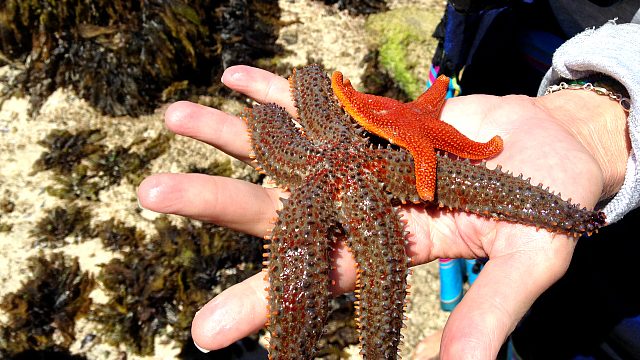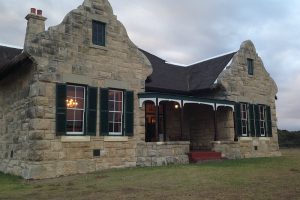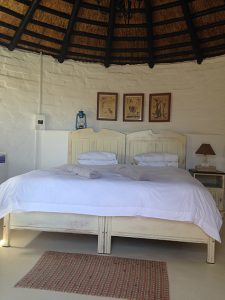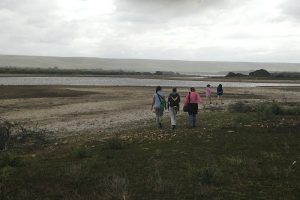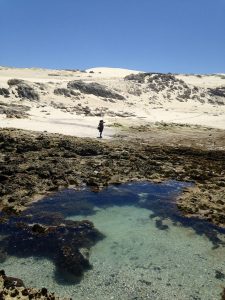Though it’s only three hours from Cape Town, De Hoop Nature Reserve truly feels like it’s in a different universe.
The journey there gradually eases you out of city life and into the rural idyll that awaits at this 36,000-hectare World Heritage site. As you pass by the quaint farm stores and golden fields of maize in towns like Grabouw, Caledon and Napier, the mobile phone reception gets weaker, the empty spaces get wider, passing cars dwindle to a trickle, and tarred road eventually turns to gravel.
After passing through the gates of the reserve, you know you have truly arrived someplace special. You are greeted by wandering herds of bontebok and eland, with the occasional ostrich showing off its bold plumage amid the endless low, scrubby fynbos. Striking white sand dunes rise up dramatically at the edge of the horizon, and the sky burns with a kaleidoscope of hues and textures.
I came to explore De Hoop with a group of five other ladies, and was looking forward to spending a weekend immersed in beauty and nature. But upon our arrival in the late afternoon, we first had to get settled in our digs at Melkkamer Manor, one of the more remote houses on the property.
We hopped onto a boat for a short ride across De Hoop Vlei, the waterway which cuts through the center of the reserve. This Ramsar (internationally recognized wetland) site is teeming with pelicans, flamingoes and other marsh birds. During the crossing we spotted porcupines hiding in the thick brush on the shore, and watched as otters splashed in the water.
But as the skies darkened and wind kicked up, it felt a bit like we were headed to Shutter Island. Our guide reminded us that the rustically beautiful house sits in a part of the reserve with no mobile phone service, generator power only til 10pm, and no way to leave until the boat returns the following morning!
But what a place to be stranded!!! The stone-gabled exterior and fireplaces in every room transported us right back to the early 20th century — but with modern comforts. Rooms were spacious and chic without being swank, in keeping with the general atmosphere and attitude of De Hoop.
De Hoop is decidedly low-key, and intentionally so – it’s a Cape Nature reserve that happens to have accommodation, not a hotel or lodge that happens to be surrounded by nature.
Most of the other accommodation centers around the main Opstal area (where the reception and restaurant are located), and ranges from simple two-person rondavels with shared kitchens and bathrooms, to multi-room suites, to camping and caravan sites. Some, like Melkkamer, are catered, while others are self-catering. If you’re in an uncatered unit and don’t feel like cooking, the Fig Tree restaurant offers gourmet food and splendid wines in a warm, friendly setting.
The variety of accommodation choices means that the reserve caters to all types of visitors, from multi-generational family groups, to couples seeking a weekend escape, to entire wedding parties (yes, you can get married on site).
My little group spent our first night enjoying a hearty meal of potjiekos and rice (with lots of wine) cooked by our amazing chef Philip, and served by guides Esmeralda and Dalfrenzo, our constant companions during the weekend. Before retiring to our rooms we read up on the history of the house and told ghost stories — which was probably not the best idea, as we all went to sleep semi-terrified.
Having made it to the morning, we stuffed ourselves with breakfast then set off on a guided nature walk around the vlei. Nature walks are one of many activities offered at the reserve, and give guests an in-depth overview of the wildlife and ecology of the area. (Other activities include bird walks, boat cruises, marine walks, quad bike tours, and mountain bike treks.)
As we skirted the edge of the vlei for the better part of three hours, the persistent grey skies evoked a feeling of melancholy. The vastly knowlegable Esmeralda periodically stopped to point out a Malachite kingfisher, the yellow flowers of Diosma echinulata, or the tracks of a rarely-seen Cape leopard, while the whipping wind and occasional rain showers reminded us of our place in the pecking order of nature.
Nature truly shapes the rhythms of life at De Hoop, from the sounds of birds hopping on the roof of your room, to the ever-changing weather, to the wild rosemary whose smell fills your nostrils as you amble down the gravel trails (while stepping carefully to avoid the ever-present animal droppings). 1500 plant species, 260 bird species, and 86 mammals make their home in the reserve, which is part of the unique but threatened Cape Floral kingdom.
Approximately 17km, two sore legs, and many bottles of water later, I finally dragged myself to the catered picnic site at the end of the hike, where the others had arrived long before. Perched at the edge of a vast plain, we watched bontebok and zebra munch on wild grass in the distance while we munched on sandwiches, salads, and bubbly (to celebrate the feat we had just accomplished, of course).
Surprisingly, my legs were not sore the next morning when we set off on another (much shorter) walk amid the dunes and tide pools of the Marine Protected Area, which stretches 5km (3 miles) out to sea. This is the winter home to hundreds of Southern Right whales, Bryde’s whales, and humpbacks. (If you’re a whale lover, book the cottage at Koppie Alleen, which overlooks the bay and offers non-stop land-based whale watching from your bedroom window.)
Since we visited in summer, there were sadly no whales to see, but there were plenty of starfish, urchins and other critters, which Esmeralda gleefully pulled from the pools to let us get a closer look at as we gingerly navigated the treacherous and slippery rocks. (Of course, she carefully put each creature back without harming it.)
The water here is cold, rough, and full of jellyfish, so we didn’t venture into the surf, instead letting the wind whip our hair while we climbed up and down the striking, powdery-white dunes snapping photos, inspecting shells, and feeling the sand between our toes.
At one point, near the end of the afternoon, I suddenly felt the urge to run. I kicked off my flip flops, dropped my bag, and hurtled headlong down a massive dune, stopping only when I was completely sweaty, out of breath and covered in sand.
It was glorious, raw and wild. Just like De Hoop.
Details:
The De Hoop Collection
Overberg District, Western Cape
Tel: 021 422 4522
E-mail: info@dehoopcollection.co.za
Website: www.dehoopcollection.co.za
How to get there:
From Cape Town, take N2 east for 200 km until you reach R319. Turn right on the gravel road just past the R319 turn. Go south for 31 km, until the road ends at a T-junction. Make a left, then a quick right after 2km. Proceed down the road for another 6.5 km until you reach the De Hoop gate, then another 4 km or so until you see the sign for the right turn to the office/reception area.
